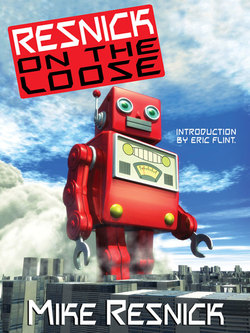Читать книгу Resnick on the Loose - Mike Resnick - Страница 12
На сайте Литреса книга снята с продажи.
ОглавлениеTelevision Has a Lot to Answer For
It was close to seven decades ago that Isaac Asimov looked around at the current state of the art, realized that except for Eando Binder’s crude, pulpish hero Adam Link, almost every robot in science fiction was a malicious monstrosity, applied a little rationality, and came up with the Three Laws of Robotics.
It was a brilliant breakthrough, and forever put an end to the kind of robots that dominated the covers and interiors of the science fiction magazines of the 1930s. In fact, it seemed reasonable to assume that from that day forward every science fictional robot would be governed by the Three Laws or some variation of them.
So what happened?
Clifford D. Simak created Jenkins, the robot servant in the classic City, a robot who felt, empathized, and could even lie in a good cause. John Sladek created Roderick, a robot whose middle name might well have been Satire. Robert Sheckley created a robot with (very humorous) sexual accomplishments. I picked up a Hugo nomination for a story about a robot whose greatest desire was to cry.
During the same time period that Asimov developed his laws, Robert A. Heinlein created the ultimate time paradox tale in his classic novella, “By His Bootstraps.” No need for anyone to ever write another.
But Heinlein himself topped it with “All You Zombies.” So did David Gerrold with The Man Who Folded Himself. So did William Tenn with “Me, Myself and I.” And none of them had anything in common with “By His Bootstraps” except that they concerned time paradoxes.
Phillip Wylie actually created the first superman in his novel, Gladiator. Then came Olaf Stapledon’s Odd John, a mental rather than a physical superman. Then came a whole series of supermen created by A. E. van Vogt. And of course there was Asimov’s Mule, and Henry Kuttner’s Baldies, and James H. Schmitz’s delightful Witches of Karres…and need I go on? The only ones who bore more than a passing resemblance to Wylie’s original were the continuing pulp character Doc Savage, and the continuing comic book character Superman.
Olaf Stapledon gave us a thinking dog in Sirius. Which was nothing like the thinking dogs Clifford D. Simak gave us a decade later in City, or Fredric Brown’s thinking dog, or Brown’s thinking mouse, or any number of thinking cats, horses, dragons, you name it. None of which had anything in common with Sirius, except that they were animals and sentient.
Okay, move the clock ahead to the 1990s and 2000s. I can’t tell you how many young people I’ve spoken to at lectures, workshops, and online who only want to write Star Trek books or Star Wars books (and in the 1990s you could add Beauty and the Beast books). The CompuServe network, back in the 1990s, had about 300 embryonic writers who only wanted to write Pern stories, even though the laws of copyright were explained to them and Anne McCaffrey had to land on a couple who ignored those laws.
For the longest time I didn’t understand it. These aren’t detective or Western stories, where you create a Sherlock Holmes or Hopalong Cassidy and tell his adventures for the rest of your career—and even in mysteries or Westerns, you created your own detective or cowboy, you didn’t swipe someone else’s.
We’re not mysteries or Westerns. We’re science fiction, which gives its writers all time and space to play with. Our galaxy has about one hundred billion stars. We’ve got at least a couple of billion Class G stars, just like our sun, and we’re starting to find out that damned near every star we examine has planets. The possibilities, scientific and fictional, are endless. So why do so many people want only to tell second-hand stories about Kirk and Spock and Picard and Skywalker in a handful of third-hand, shopworn, thoroughly-explored and not-very-logical universes?
When they see something that interests them or impresses them, why don’t they do what Simak did when he read about Asimov’s robots, what van Vogt did with he read about Wylie’s and Stapledon’s supermen, what Gerrold did when he encountered Heinlein’s time paradoxes? Why are the book and magazine slushpiles filled almost to overflowing with thinly-disguised Enterprises and Darth Vaders and the like?
And then it occurred to me. There is one major difference between most of the writers I named, and all of the hopeful ones I’ve been encountering for the past decade or so…and that is that most of the writers I named did not grow up watching television. Television didn’t exist during their formative years, so they grew up reading. They did not watch the same unchanging characters in the same trite, interchangeable plots week in and week out. They did not spend hours every night exposed to uncreative, unthreatening mental pablum that convinces each new generation of couch potato that it is Art. And, uninfluenced by the tube, they kept science fiction lively, creative and innovative.
Conclusion: even our here in the boonies where written science fiction lives, television has a lot to answer for.
